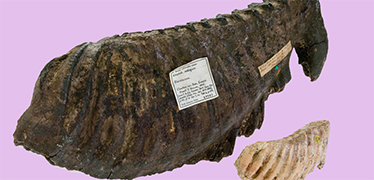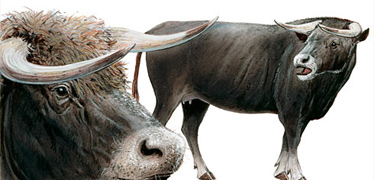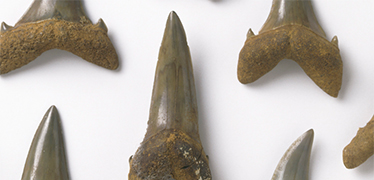
A microscopic view of small gastropods in a slice of rock from the earliest Triassic hothouse world.
From shrinking shellfish to bulked-up bison, animals often adapt to environmental change by increasing or decreasing in size.
Because size is well-preserved in the fossil record, scientists have an invaluable record of the biotic responses to changing environments.
Body size research led by Museum palaeontologists Professor Adrian Lister and Professor Richard Twitchett could help predict the impact of our rapidly changing climate.
'The past is the only opportunity we have to study how biota responds on timescales longer than a few years,' says Prof Lister.
'Body size is a key indicator of an animal's ability to survive and reproduce, so records of size variation in response to past temperature changes can help us judge how the biota may respond to present and future climate change.'
The palaeontologists study body size in very different contexts. Prof Twitchett focuses on marine organisms and looks at reductions in size, while Prof Lister studies fluctuations in the size of Ice Age mammals and island dwarfing.
Shrink and swim
In the immediate aftermath of extinction events, the surviving animals tend to become temporarily a lot smaller.
Prof Twitchett studies this 'Lilliput effect' in marine animals that survived the three major extinction events of the Mesozoic Era (252 to 66 million years ago). He investigates why the phenomenon seems ubiquitous across geological time and faunal groups:
'We're looking at size reduction in the surviving taxa, so it's not simply about large species being more vulnerable to extinction. Following the decrease in size, we see an increase - the Lilliput effect is a temporary thing.'
'It's basically about environmental stress, as these post-extinction times are also peak greenhouse times.'
The proportion of gases in the atmosphere that absorb infrared radiation rises in greenhouse periods, causing an overall increase in global temperature. For marine organisms, that equals stress - and stress can make you smaller.
Stressed shellfish
Greenhouse conditions are common after major extinction events, and marine survivors find themselves living in waters that are warmer and therefore less able to hold oxygen.
Less oxygen means organisms must reduce the share of their cellular energy that goes towards growth in order to maintain other essential processes, such as keeping a hard shell around their body.
Scientists thought that soft-bodied creatures such as polychete worms and burrowing invertebrates might have been protected from the Lilliput effect, since they had no need to expend energy maintaining a hard shell.
But Prof Twitchett's research shows that they too experienced a size reduction, indicating that severe environmental stresses affect the entire spectrum of marine fauna.
Temperature itself is another strain on marine organisms.
As temperatures rise, the animal's metabolic rate increases. This may cause the animal to mature faster and to a smaller size.
Other potential triggers for size reduction in marine organisms include water salinity, high sedimentation rates and low food availability.

Metatarsal bones (cannon bones of the hind limb) of red deer, (A) Gough’s Cave, Somerset, 13,000 years old, (B) Crayford, Kent, 200,000 years old, (C) Ghar Dalam, Malta, around 20,000 years old.
The fossils illustrate the great flexibility in body size of this species, which appears to be related to environment.
Largeness on land
Land-dwelling animals experience different pressures, but their size is similarly bound to variations in environment and climate.
Prof Lister and his team study the cause of changing body size in mammals that lived across southern Britain over the past 750,000 years.
They aim to determine why there is a dramatic variation in the size of fossil bones from individual species between sites and time periods.
Using bone measurements to calculate estimates of body mass, they found that the size of the species studied depended on temperature, vegetation type, or both. It was difficult to separate the two causes, Prof Lister admits:
'The two potential drivers are correlated - warm conditions usually mean forest, and cold conditions equate with open grassland. To separate the percentage of size variation unique to each cause we used a statistical method – commonality analysis.'
Their analysis showed that the cause of size change varied between species.
Fallow deer and spotted hyena conformed to 'Bergmann's rule', which states that larger individuals (which have a greater surface area-to-volume ratio) are better at retaining heat and therefore thrive in colder environments.
Smaller animals have a greater relative surface area to lose heat from, making them less successful in cold environments.

Prof Adrian Lister and colleagues studied red deer and wolves that lived in southern Britain during the last 750,000 years. They found that individuals living in forests were generally smaller than those living on open plains. Wolf image © Robert Dewar. Licensed under CC BY 2.0.
The Lilliput effect and Bergmann's rule apply to different contexts, but draw the same conclusion about body size: when temperatures increase, animals tend to get smaller.
However, Prof Lister found that not all mammal species conform to Bergman's rule. Horses and reindeer, for example, do not get larger with decreased temperature, perhaps because they have such good physiological adaptations.
Other species' body sizes seem more sensitive to vegetation than climate.
Red deer and wolves living in forested environments were generally smaller than those on open plains, perhaps because forest environments yielded less or lower quality food.
Future research will focus on these complexities, as well as the effect of predator-prey dynamics.
Prof Lister and his colleagues are also studying size reduction in elephants and deer that lived on Mediterranean islands 800,000 to 3,000 years ago.
These 'island dwarfs' are affected by climate fluctuations more quickly and intensely than mainland species, providing a magnified example of how biota may respond to environmental change in the future.
Why size matters
Body size is a key indicator of an animal's fertility, lifespan, and ability to survive a food shortage or drought.
This means that any environmentally driven change in body size may significantly affect the broader ecosystem, as well as the species' own success.
Recent studies have confirmed that the body size of many animals is predicted to decrease in the near future in response to a warming climate and increasingly variable levels of rainfall.
Projections suggest that the degree of shrinking may vary between organisms, upsetting ecosystem balances and threatening human food sources such as crop plants and fish.
Scientists like Prof Twitchett and Prof Lister are quantifying biotic responses, bringing the hazards of environmental change further into the global consciousness. But to learn more, we need more data.
Prof Twitchett says:
'The Museum collections give you a great broad view of trends in size variation. But if we really want to look at deep-time body size change in high resolution, we need to generate new collections and datasets.'
An ongoing Museum project to digitise a collection of hundreds of thousands of brachiopods and bivalves will allow our scientists to extract a huge dataset of body size change over the last 250 million years.
Museum team
Collaborators
- Dr Tom White
University of Oxford - Dr Sarah Collinge
Natural Environment Research Council (NERC)
Publications
Garilli V, Rodolfo-Metalpa R, Scuderi D, Brusca L, Parrinello D, Rastrick SPS, Foggo A, Twitchett RJ, Hall-Spencer JM and Milazzo M (2015). Physiological advantages of dwarfing in surviving extinctions in high-CO2 oceans. Nature Climate Change.
Chen YL, Twitchett RJ, Jiang HS, Richoz S, Lai XL, Yan CB, Sun YD, Liu XD and Wang L (2013). Size variation of conodonts during the Smithian-Spathian (Early Triassic) global warming event. Geology, 41, 823-826.
Metcalfe B, Twitchett RJ and Price-Lloyd N (2011). Size and growth rate of ‘Lilliput’ animals in the earliest Triassic. Palaeogeography, Palaeoclimatology, Palaeoecology, 308, 171-180.
Morten SD and Twitchett RJ (2009). Fluctuations in the body size of marine invertebrates through the Pliensbachian-Toarcian extinction event. Palaeogeography, Palaeoclimatology, Palaeoecology, 284, 29-38.
Twitchett RJ (2007). The Lilliput effect in the aftermath of the end-Permian extinction event. Palaeogeography, Palaeoclimatology, Palaeoecology 252, 132-144.
Estimating palaeoenvironments
Scientists use proxies to infer past environmental conditions. Ideally, this means collecting proxy data from the same strata and sediment as the fossils of interest.
Proxies can correlate to air or water temperature, water chemistry, vegetation type and precipitation. Prof Lister and Prof Twitchett collected and studied existing proxy data to infer palaeoenvironmental conditions during times of body size change.
Proxies include:
- Marine fossils: Many marine species, such as ostracods, thrive at specific temperatures, so their fossil assemblages can indicate a minimum and maximum temperature for winter and summer. The shells of marine organisms such as foraminifera, oysters and brachiopods are produced in isotopic equilibrium with the seawater in which they form, so fossilised shells can also preserve the chemistry of seawater at a given point in time.
- Pollen: Preserved pollen spores reflect the type of vegetation present at a given time and the relative proportions of each species. This can reveal the temperature range or precipitation rates for a given time.
- Fossil plants: Atmospheric CO2 can be estimated from the density of stomata in the plant leaf. The type and shape of plant leaves and assemblages of plants in a given area can also act as a proxy for precipitation levels and overall climate.

Origins, evolution and futures
Our scientists are studying the Earth's origins, environment and the evolution of life.


